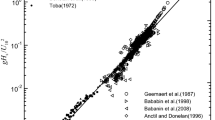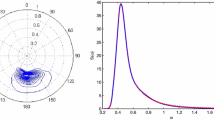Abstract
The impact of air-flow separation from breaking dominant waves is analyzed.This impact results from the correlation of the pressure drop with theforward slope of breaking waves. The pressure drop is parameterized via thesquare of the reference mean velocity. The slope of breaking waves isrelated to the statistical properties of the wave breaking fronts describedin terms of the average total length of breaking fronts. Assuming that thedominant waves are narrow and that the length of breaking fronts is relatedto the length of the contour of the breaking zone it is shown that theseparation stress supported by dominant waves is proportional to thebreaking probability of dominant waves. The breaking probability of dominantwaves, in turn, is defined by the dominant wave steepness. With thedominant wave steepness increasing, the breaking probability is increasedand so does the separation stress. This mechanism explains wave age (youngerwaves being steeper) and finite depth (the spectrum is steeper in shallowwater) dependence of the sea drag. It is shown that dominant waves support asignificant fraction of total stress (sea drag) for young seas due to theair-flow separation that occurs when they break. A good comparison of themodel results for the sea drag with several data sets is reported.
Similar content being viewed by others
References
Babanin, A. V., Young, I. R., and Banner, M. L.: 2001, 'Breaking Probability for Dominant Waves on Water of Finite Constant Depth', J. Geophys. Res. 106, 11659-11676.
Banner, M. L., Babanin, A. V., and Young, I. R.: 2000, 'Breaking Probability for Dominant Waves on the Sea Surface', J. Phys. Oceanog. 30, 3145-3160.
Donelan, M. A.: 1990, 'Air-Sea Interaction', in The Sea: Ocean Engineering Science, Vol. 9, pp. 239-292.
Donelan, M. A., Dobson, F.W., Smith, S. D., and Anderson, R. J.: 1993, 'On the Dependence of Sea Surface Roughness on Wave Development', J. Phys. Oceanog. 23, 2143-2149.
Donelan, M. A., Hamilton, J., and Hui, W. H.: 1985, 'Directional Spectra ofWind GeneratedWaves', Phil. Trans. Roy. Soc. London, Ser. A 315, 509-562.
Drennan, W. M., Graber, H. C., Hauser, D., and Quentin, C.: 2002, 'On the Wave Age Dependence of Wind Stress over Pure Wind Seas', J. Geophys. Res., in press.
Elfouhaily, T., Chapron, B., Katsaros, K., and Vandemark, D.: 1997, 'A Unified Directional Spectrum for Long and Short Wind Driven Waves', J. Geophys. Res. 102, 15,781-15,796.
Geernaert, G. L.: 1990, 'Bulk Parameterizations for the Wind Stress and Heat Fluxes', in G. L. Geernaert and W. J. Plant (eds.), Surface Waves and Fluxes, Vol. 1, Kluwer Academic Publishers, Dordrecht, pp. 91-172.
Geernaert, G. L., Katsaros, K. B., and Richter, K.: 1986, 'Variation of the Drag Coefficient and its Dependence on Sea State', J. Geophys. Res. 91, 1580-1584.
Janssen, J. A. M.: 1997, 'Does Wind Stress Depend on Sea-State or Not?-A Statistical Error Analysis of HEXMAX Data', Boundary-Layer Meteorol. 83, 479-503.
Keller, M. R., Keller, W. C., and Plant, W. J.: 1992, 'A Wave Tank Study of the Determination of Xband Cross Sections on Wind Speed and Water Temperature', J. Geophys. Res. 97, 5771-5792.
Kudryavtsev, V. N. and Makin, V. K.: 2001, 'The Impact of Air-Flow Separation on the Drag of the Sea Surface', Boundary-Layer Meteorol. 98, 155-171.
Kudryavtsev, V. N., Makin, V. K., and Chapron, B.: 1999, 'Coupled Sea Surface-Atmosphere Model 2. Spectrum of Short Wind Waves', J. Geophys. Res. 104, 7625-7639.
Longuet-Higgins, M. S.: 1957, 'The Statistical Analysis of a Random Moving Surface', Phil. Trans. Roy. Soc. London, Ser. A 249, 321-387.
Maat, N., Kraan, C., and Oost, W. A.: 1991, 'The Roughness of the Sea Surface', Boundary-Layer Meteorol. 54, 89-103.
Makin, V. K. and Kudryavtsev, V. N.: 1999, 'Coupled Sea Surface-Atmosphere Model 1. Wind over Waves Coupling', J. Geophys. Res. 104, 7613-7623.
Makin, V. K., Kudryavtsev, V. N., and Mastenbroek, C: 1995, 'Drag of the Sea Surface', Boundary-Layer Meteorol. 79, 159-182.
Oost, W. A.: 1998, 'The KNMI HEXMAX Stress Data-A Reanalysis', Boundary-Layer Meteorol. 86, 447-468.
Oost, W. A., Komen, G. J., Jacobs, C. M. J., and van Oort, C.: 2002, 'New Evidence for a Relation betweenWind Stress andWave Age fromMeasurements during ASGAMAGE', Boundary-Layer Meteorol., in press.
Phillips, O. M.: 1985, 'Spectral and Statistical Properties of the Equilibrium Range in Wind Generated GravityWaves', J. Fluid Mech. 156, 505-531.
Smith, S. D., Anderson, R. J., Oost, W. A., Kraan, C., Maat, N., DeCosmo, J., Katsaros, K. B., Davidson, K. L., Bumke, K., Hasse, L., and Chadwick, H. M.: 1992, 'Sea Surface Wind Stress and Drag Coefficients: The HEXOS Results', Boundary-Layer Meteorol. 60, 109-142.
Srokosz, M. A.: 1985, 'On the Probability of Wave Breaking in Deep Water', J. Phys. Oceanog. 16, 382-385.
Taylor, P. K. and Yelland, M. J.: 2001, 'The Dependence of Sea Surface Roughness on the Height and Steepness of the Waves', J. Phys. Oceanog. 31, 572-590.
Xu, D., Liu, X., and Yu, D.: 2000, 'Probability of Wave Breaking and Whitecap Coverage in a Fetch-Limited Sea', J. Geophys. Res. 105, 14253-14259.
Yelland, M. and Taylor, P. K.: 1996, 'Wind Stress Measurements from the Open Ocean', J. Phys. Oceanog. 26, 541-558.
Young, I. R. and Verhagen, L. A.: 1996, 'The Growth of Fetch Limited Waves in Water of Finite Depth. Part 2. Spectral Evolution', Coastal Eng. 29, 79-99.
Author information
Authors and Affiliations
Rights and permissions
About this article
Cite this article
Makin, V., Kudryavtsev, V. Impact Of Dominant Waves On Sea Drag. Boundary-Layer Meteorology 103, 83–99 (2002). https://doi.org/10.1023/A:1014591222717
Issue Date:
DOI: https://doi.org/10.1023/A:1014591222717




